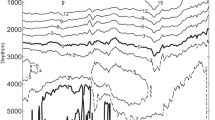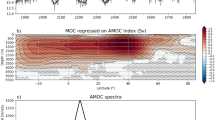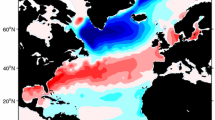Abstract
The significance of the Atlantic meridional overturning circulation (MOC) for regional and hemispheric climate change requires a complete understanding using fully coupled climate models. Here we present a persistent, decadal oscillation in a coupled atmosphere–ocean general circulation model. While the present study is limited by the lack of comparisons with paleo-proxy records, the purpose is to reveal a new theoretically interesting solution found in the fully-coupled climate model. The model exhibits two multi-century-long stable states with one dominated by decadal MOC oscillations. The oscillations involve an interaction between anomalous advective transport of salt and surface density in the North Atlantic subpolar gyre. Their time scale is fundamentally determined by the advection. In addition, there is a link between the MOC oscillations and North Atlantic Oscillation (NAO)-like sea level pressure anomalies. The analysis suggests an interaction between the NAO and an anomalous subpolar gyre circulation in which sea ice near and south of the Labrador Sea plays an important role in generating a large local thermal anomaly and a meridional temperature gradient. The latter induces a positive feedback via synoptic eddy activity in the atmosphere. In addition, the oscillation only appears when the Nordic Sea is completely covered by sea ice in winter, and deep convection is active only near the Irminger Sea. Such conditions are provided by a substantially colder North Atlantic climate than today.

















Similar content being viewed by others
References
Aeberhardt M, Blatter M, Stocker TF (2000) Variability on the century time scale and regime changes in a stochastically forced zonally averaged ocean–atmosphere model. Geophys Res Lett 27(9):1303–1306
Ammann CM, Meehl GA, Washington WM, Zender CS (2003) A monthly and latitudinally varying volcanic forcing dataset in simulations of 20th century climate. Geophys Res Lett 30(12):L1657, doi:10.1029/2003GL016875
Blackmon ML (1976) A climatological spectral study of the 500 mb geopotential height of the Northern Hemisphere. J Atmos Sci 33(8):1607–1623
Blunier T, Brook EJ (2001) Timing of millennial-scale climate change in Antarctica and Greenland during the last glacial period. Science 291(5501):109–112
Blunier T, Chappellaz J, Schwander J, Dällenbach A, Stauffer B, Stocker TF, Raynaud D, Jouzel J, Clausen HB, Hammer C, Johnsen SJ (1998) Asyncrony of Antarctic and Greenland climate change during the last glacial period. Nature 394:739–743
Blunier T, Chappellaz J, Schwander J, Stouffer B, Raynaud D (1995) Variations in atmospheric methane concentration during the Holocene epoch. Nature 374(6517):46–49
Bretherton CS, Widmann M, Dymnikov VP, Wallace JM, Bladé I (1999) The effective number of spatial degrees of freedom of a time-varying field. J Clim 12(7):1990–2009
Broecker WS (1998) Paleocean circulation during the last deglaciation: a bipolar seasaw? Paleoceanography 13(2):119–121
Bryan FO, Danabasoglu G, Nakashiki N, Yoshida Y, Kim DH, Tsutui J, Doney SC (2006) Response of the North Atlantic thermohaline circulation and ventilation to increasing carbon dioxide in CCSM3. J Clim 19(11):2382–2397
Bryan K (1984) Accelerating the convergence to equilibrium of ocean-climate models. J Phys Oceanogr 14(4):666–673
Bryan K, Hansen FC (1995) A stochastic model of North Atlantic climate variability on decade-to-century time scales. In: CR Committee (ed) Natural climate variability on decade-to-century time scales. National Research Council, Washington, pp 355–364
Collins WD, Bitz CM, Blackmon ML, Bonan GB, Bretherton CS, Cargon JA, Chang P, Doney SC, Hack JJ, Henderson TB, Kiehl JT, Large WG, McKenna DS, Snater BD, Smith RD (2006a) The community climate system model version 3 (CCSM3). J Clim 19(11):2122–2143
Collins WD, Rasch PJ, Boville BA, Hack JJ, McCaa JR, Williamson DL, Briegleb BP, Bitz CM, Lin SJ, Zhang M (2006b) The formulation and atmospheric simulation of the community atmosphere model version 3 (CAM3). J Clim 19(11):2144–2161
Crowley TJ (2000) Causes of climate change over the past 1000 years. Science 289(5477):270–277
Cunningham SA, Kanzow T, Rayner D, Baringer MO, Johns WE, Marotzke J, Longworth HR, Grant EM, Hirschi JJM, Beal LM, Meinen CS, Bryden HL (2007) Temporal variability of the Atlantic meridional overturning circulation at 26.5°N. Science 317(5840):935–938
Dai A, Hu A, Meehl GA, Washington WM, Strand WG (2005) Atlantic thermohaline circulation in a coupled general circulation model: unforced variations versus forced changes. J Clim 18(16):3270–3293
Danabasoglu G (2008) On multidecadal variability of the Atlantic meridional overturning circulation in the Community Climate System Model version 3. J Clim 21(21):5524–5544
de Vernal A, Rosell-Melé A, Kucera M, Hillaire-Marcel C, Eynaud F, Weinelt M, Dokken T, Kageyama M (2006) Comparing proxies for the reconstruction of LGM sea-surface conditions in the northern North Atlantic. Quat Sci Rev 25(21–22):2820–2834
Delworth T, Manabe S, Stouffer J (1993) Interdecadal variations of the thermohaline circulation in a coupled ocean-atmosphere model. J Clim 6(11):1993–2011
Delworth TL, Greatbatch RJ (2000) Multidecadal thermohaline circulation variability driven by atmospheric surface flux forcing. J Clim 13(9):1481–1495
Delworth TL, Stouffer RJ, Dixon KW, Spelman MJ, Knutson TR, Broccoli AJ, Kushner PJ, Wetherald RT (2002) Review of simulations of climate variability and change with the GFDL R30 coupled climate model. Clim Dyn 19(7):555–574
Deser C, Magnusdottir G, Saravanan R, Phillips A (2004) The effects of North Atlantic SST and sea ice anomalies on the winter circulation in CCM3. part II: direct and indirect components of the response. J Clim 17(5):877–889
Dong B, Sutton RT (2005) Mechanism of interdecadal thermohaline circulation variability in a coupled ocean–atmosphere GCM. J Clim 18(8):1117–1135
Etheridge DM, Steele LP, Langenfelds RL, Francey RJ, Barnola JM, Morgan VI (1996) Natural and anthropogenic changes in atmospheric CO2 over the last 1000 years from air in Antarctic ice and firn. J Geophys Res 101(D2):4115–4128
Flückiger J, Dällenbach A, Blunier T, Stauffer B, Stocker TF, Raynaud D, Barnola JM (1999) Variations in atmospheric N2O concentration during abrupt climatic changes. Science 285(5425):227–230
Flückiger J, Monnin E, Stauffer B, Schwander J, Stocker TF, Chappellaz J, Raynaud D, Barnola JM (2002) High-resolution Holocene N2O ice core record and its relationship with CH4 and CO2. Global Biogeochem Cycles 16(1):L1010, doi:10.1029/2001GB001417
Ganachaud A (2003) Large-scale mass transports, water mass formation, and diffusivities estimated from World Ocean Circulation Experiment (WOCE) hydrographic data. J Geophys Res 108(C7):3213, doi:10.1029/2002JC001565
Ganachaud A, Wunsch C (2000) Improved estimates of global ocean circulation, heat transport and mixing from hydrographic data. Nature 408:453–457
Gent PR, McWilliams JC (1990) Isopycnal mixing in ocean circulation models. J Phys Oceanogr 20(1):150–155
González-Rouco JF, Beltrami H, Zorita E, von Storch H (2006) Simulation and inversion of borehole temperature profiles in surrogate climates: spatial distribution and surface coupling. Geophys Res Lett 33:L01703, doi:10.1029/2005GL024693
Greatbatch RJ, Zhang S (1995) An interdecadal oscillation in an idealized ocean basin forced by constant heat flux. J Clim 8(1):81–91
Griffies SM, Tziperman E (1995) A linear thermohaline oscillator driven by stochastic atmospheric forcing. J Clim 8(10):2440–2453
Grosfeld K, Lohmann G, Rimbu N, Fraedrich K, Linkeit F (2007) Atmospheric multidicadal variations in the North Atlantic realm: Proxy data, observations, and atmospheric circulation model studies. Clim Past 3:39–50
Holland MM, Bitz CM, Eby M, Weaver AJ (2001) The role of ice-ocean interactions in the variability of the North Atlantic thermohaline circulation. J Clim 14(5):656–675
Hoskins BJ, James IN, White GH (1983) The shape, propagation and mean-flow interaction of large-scale weather systems. J Atmos Sci 40(7):1595–1612
Hughes TMC, Weaver AJ (1994) Multiple equilibria of an asymmetric two-basin ocean model. J Phys Oceanogr 24(3):619–637
Hurrell JW, Visbeck M, Busalacchi A, Clarke RA, Delworth TL, Dickson RR, Johns WE, Koltermann KP, Kushnir Y, Marshall D, Mauritzen C, McCartney MS, Piola A, Reason C, Reverdin G, Schott F, Sutton R, Wainer I, Wright D (2006) Atlantic climate variability and predictability: a CLIVAR perspective. J Clim 19:5100–5121
IPCC (2001) Climate change 2001: the scientific basis. In: Houghton JT, Ding Y, Griggs DJ, Noguer M, van der Linden PJ, Dai X, Maskell K, Johnson CA (eds) Contribution of working group I to the third assessment report of the intergovenmental panel on climate change. Cambridge University Press, Cambridge, 881 pp
IPCC (2007) Climate change 2007: the physical science basis. In: Solomon S, Qin D, Manning M, Chen Z, Marquis M, Averyt KB, Tignor M, Miller HL (eds) Contribution of working group I to the fourth assessment report of the intergovenmental panel on climate change. Cambridge University Press, Cambridge, 996 pp
Jungclaus JH, Haak H, Latif M, Mikolajewicz U (2005) Arctic-North Atlantic interactions and multidecadal variability of the meridional overturning circulation. J Clim 18(19):4013–4031
Knutti R, Flückiger J, Stocker TF, Timmermann A (2004) Strong hemispheric coupling of glacial climate through freshwater discharge and ocean circulation. Nature 430:851–856
Kushnir Y, Robinson WA, Bladé I, Hall NMJ, Peng S, Sutton R (2002) Atmospheric GCM response to extratropical SST anomalies: synthesis and evaluation. J Clim 15(16):2233–2256
Large WG, Danabasoglu G (2006) Attribution and impacts of upper-ocean biases in CCSM3. J Clim 19(11):2325–2346
Large WG, McWilliams JC, Doney SC (1994) Oceanic vertical mixing: a review and a model with a nonlocal boundary layer parameterization. Rev Geophys 32(4):363–403
Lean J, Beer J, Bradley R (1995) Reconstruction of solar irradiance since 1610: Implications for climate change. Geophys Res Lett 22(23):3195–1398
Luksch U, Raible CC, Blender R, Fraedrich K (2005) Decadal cyclone variability in the North Atlantic. Meteorol Z 14(6):747–753
Lumpkin R, Speer K (2003) Large-scale vertical and horizontal circulation in the North Atlantic ocean. J Phys Oceanogr 33(9):1902–1920
Magnusdottir G, Deser C, Saravanan R (2004) The effects of North Atlantic SST and sea ice anomalies on the winter circulation in CCM3. part I: main features and storm track characteristics of the response. J Clim 17(5):857–876
Manabe S, Stouffer RJ (1988) Two stable equilibria of a coupled ocean–atmosphere model. J Clim 1(9):841–866
Mann ME, Zhang Z, Hughes MK, Bradley RS, Miller SK, Rutherford S, Ni F (2008) Proxy-based reconstructions of hemispheric and global surface temperature variations over the past two millennia. Proc Natl Acad Sci USA 105(36):13252–13257
Mikolajewicz U, Maier-Reimer E (1994) Mixed boundary conditions in ocean general circulation models and their influence on the stability of the model’s conveyor belt. J Geophys Res 99(C11):22633–22644
Oleson KW, Dai Y, Bonan G, Rosilovich M, Dickinson R, Dirmeyer P, Hoffman F, Houser P, Levis S, Niu GY, Thornton P, Vertenstein M, Yang ZL, Zeng X (2004) Technical description of the community land model (CLM). NCAR Technical Note, NCAR/TN-461+STR, 173 pp
Otto-Bliesner BL, Tomas R, Brady EC, Ammann C, Kothavala Z, Clauzet G (2006) Climate sensitivity of moderate- and low-resolution versions of CCSM3 to preindustrial forcings. J Clim 19(11):2567–2583
Peng S, Whitaker JS (1999) Mechanisms determining the atmospheric response to midlatitude SST anomalies. J Clim 12(5):1393–1408
Press WH, Teukolsky SA, Vetterling WT, Flannery BP (1992) Numerical recipes in FORTRAN: the art of scientific computing, 2nd edn, Cambridge University Press, New York, 963 pp
Rahmstorf S (1996) Comments on "Instability of the thermohaline circulation with respect to mixed boundary conditions: is it really a problem for realistic models?" J Phys Oceanogr 26(6):1099–1105
Rahmstorf S, Willebrand J (1995) The role of temperature feedback in stabilizing the thermohaline circulation. J Phys Oceanogr 25(5):787–805
Rind D, Shindell D, Perlwitz J, Lerner J, Lonergan P, Lean J, McLinden C (2004) The relative importance of solar and anthropogenic forcing of climate change between the Maunder Minimum and the present. J Clim 17(5):906–929
Smethie WM Jr, Fine RA (2001) Rates of North Atlantic deep water formation calculated from chlorofluorocarbon inventories. Deep Sea Res Part I 48(1):189–215
Stocker TF (1998) The seesaw effect. Science 282(5386):61–62
Stocker TF (2000) Past and future reorganizations in the climate system. Quat Sci Rev 19(1–5):301–319
Stocker TF, Johnsen SJ (2003) A minimum thermodynamic model for the bipolar seesaw. Paleoceanography 18(4):1087, doi:10.1029/2003PA000920
Stocker TF, Timmermann A, Renold M, Timm O (2007) Effects of salt compensation on the climate model response in simulations of large changes of the Atlantic meridional overturning circulation. J Clim 20(24):5912–5928
Stouffer RJ, Yin J, Gregory JM, Dixon KW, Spelman MJ, Hurlin W, Weaver AJ, Eby M, Flato GM, Hasumi H, Hu A, Jungclaus JH, Kamenkovich IV, Levermann A, Montoya M, Murakami S, Nawrath S, Oka A, Peltier WR, Robitaille DY, Sokolov A, Vettoretti G, Weber SL (2006) Investigating the causes of the response of the thermohaline circulation to past and future climate changes. J Clim 19(8):1365–1387
Talley LD, Raid JL, Robbins PE (2003) Data-based meridional overturning streamfunctions for the global ocean. J Clim 16(19):3213–3226
Thorpe RB, Gregory JM, Johns TC, Wood RA, Mitchell JFB (2001) Mechanisms determining the Atlantic thermohaline circulation response to greenhouse gas forcing in a non-flux-adjusted coupled climate model. J Clim 14(14):3102–3116
Timmermann A, Latif M, Voss R, Grötzner A (1998) Northern Hemisphere interdecadal variability: a coupled air-sea mode. J Clim 11(8):1906–1931
Toggweiler JR, Tziperman E, Feliks Y, Bryan K, Griffies SM, Samuels B (1996) Reply. J Phys Oceanogr 26(6):1106–1110
Torrence C, Compo GP (1998) A practical guide to wavelet analysis. Bull Am Meteor Soc 79(1):61–78
Tziperman E, Toggweiler JR, Bryan K, Feliks Y (1994) Instability of the thermohaline circulation with respect to mixed boundary conditions: is it really a problem for realistic models? J Phys Oceanogr 24(2):217–232
Vellinga M, Wood RA (2002) Global climatic impacts of a collapse of the Atlantic thermohaline circulation. Clim Chan 54(3):251–267
Vellinga M, Wu P (2004) Low-latitude freshwater influence on centennial variability of the Atlantic thermohaline circulation. J Clim 17(23):4498–4511
Visbeck M, Chassignet E, Curry R, Delworth T, Dickson B, Krahmann G (2003) The Ocean’s response to North Atlantic Oscillation variability, Geophysical monograph series, chap 6, vol 134. American Geophysical Union, Washington, pp 113–146
von Storch H, Zwiers FW (1999) Statistical analysis in climate research. Cambridge University Press, Cambridge, 484 pp
Walter K, Luksch U, Fraedrich K (2001) A response climatology of idealized midlatitude thermal forcing experiments with and without a storm track. J Clim 14(4):467–484
Weaver AJ, Hughes TMC (1994) Rapid interglacial climate fluctuations driven by North Atlantic ocean circulation. Nature 367:447–450
Weaver AJ, Marotzke J, Cummins PF, Sarachik ES (1993) Stability and variability of the thermohaline circulation. J Phys Oceanogr 23(1):39–60
Weaver AJ, Sarachik ES (1991a) Evidence for decadal variability in an ocean general circulation model: an advective mechanism. Atmos Ocean 29:197–231 (RW Stewart symposium special edition)
Weaver AJ, Sarachik ES (1991b) The role of mixed boundary conditions in numerical models of the ocean’s climate. J Phys Oceanogr 21(9):1470–1493
Weaver AJ, Sarachik ES, Marotzke J (1991) Freshwater flux forcing of decadal and interdecadal oceanic variability. Nature 353(6347):836–838
Weisse R, Mikolajewicz U, Maier-Reimer E (1994) Decadal variability of the North Atlantic in an ocean general circulation model. J Geophys Res 99(C6):12411–12421
Wilks DS (1995) Statistical methods in the atmospheric sciences. In: International geophysics series, vol 59. Acdemic Press, San Diego, 467 pp
Yang J, Neelin JD (1993) Sea-ice interactions with the thermohaline circulation. Geophys Res Lett 20(2):217–220
Yang JY, Neelin JD (1997) Decadal variability in coupled sea-ice-thermohaline circulation systems. J Clim 10(12):3059–3076
Yeager SG, Shields CA, Large WG, Hack JJ (2006) The low-resolution CCSM3. J Clim 19(11):2545–2566
Yoshimori M, Raible CC, Stocker TF, Renold M (2006) On the interpretation of low-latitude hydrological proxy records based on Maunder Minimum AOGCM simulations. Clim Dyn 27(5):493–513
Yoshimori M, Stocker TF, Raible CC, Renold M (2005) Externally forced and internal variability in ensemble climate simulations of the Maunder Minimum. J Clim 18(20):4253–4270
Zhang R, Delworth TL (2005) Simulated tropical response to a substantial weakening of the Atlantic thermohaline circulation. J Clim 18(12):1853–1860
Zhang S, Greatbatch RJ, Lin CA (1993) A reexamination of the polar halocline catastrophe and implications for coupled ocean–atmosphere modeling. J Phys Oceanogr 23(2):287–299
Zhang S, Lin CA, Greatbatch RJ (1995) A decadal oscillation due to the coupling between an ocean circulation model and a thermodynamic sea-ice model. J Mar Res 53(1):79–106
Acknowledgments
We would like to thank NCAR for their continuous effort in developing, improving, and releasing the Community Climate System Model. The restart files kindly provided by NCAR saved an enormous amount of our computational time. We thank Steve Yeager in the NCAR Ocean Model Working Group for his technical help. Constructive comments by three anonymous reviewers are greatly appreciated. Developers of freely available softwares, SCRIP, NCL, and Ferret are also appreciated. This work is supported by the National Centre of Competence in Research (NCCR) Climate funded by the Swiss National Science Foundation and the EU project EPICA MIS. A substantial part of the computations was conducted on IBM Power 4 at the Swiss National Supercomputing Centre (CSCS) in Manno. Stefan Zoller and Kay Bieri maintained the local computing facility.
Author information
Authors and Affiliations
Corresponding author
Rights and permissions
About this article
Cite this article
Yoshimori, M., Raible, C.C., Stocker, T.F. et al. Simulated decadal oscillations of the Atlantic meridional overturning circulation in a cold climate state. Clim Dyn 34, 101–121 (2010). https://doi.org/10.1007/s00382-009-0540-9
Received:
Accepted:
Published:
Issue Date:
DOI: https://doi.org/10.1007/s00382-009-0540-9




